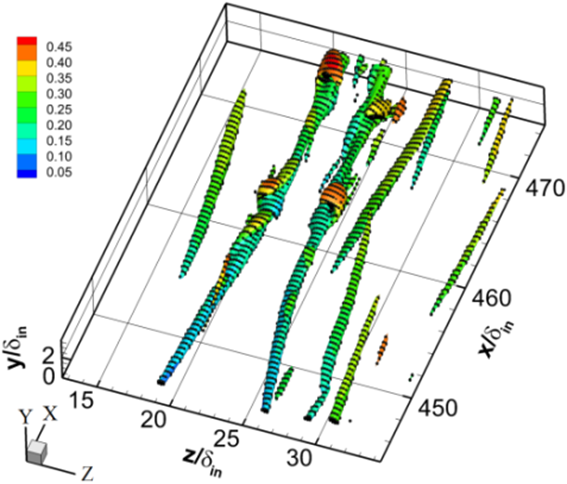Studies on nonlinear vortex dynamics in the later-stage of laminar-turbulent transition in compressible boundary layers
JAXA Supercomputer System Annual Report April 2018-March 2019
Report Number: R18EACA13
Subject Category: JSS2 Inter-University Research
- Responsible Representative: Kazuo Matsuura, Associate Professor, Ehime University, Graduate School of Science and Engineering
- Contact Information: Kazuo Matsuura(matsuura.kazuo.mm@ehime-u.ac.jp)
- Members: Kazuo Matsuura
Abstract
In hypersonic transitional flows, there are many complicated factors such as density fluctuation and temperature fluctuation due to the co-existence of the region slower than the speed of sound and the region faster than the speed of sound inside the boundary layer. Detailed investigations into the vortex dynamics occurring inside the boundary layers are expected. In this study, we aim to clarify the nonlinear vortex dynamics especially in the late-stage by conducting direct numerical simulations of laminar-turbulent transition in compressible boundary layers observed in hypersonic flows. Also, we develop a mathematical methodology to directly introduce vortices responsible for the late stage to the boundary layers, and its computational methods.
Reference URL
N/A
Reasons for using JSS2
For the investigation of boundary layer transition of hypersonic flows, numerical simulation is a central tool because measurement is difficult due to the existence of acoustical disturbance in a wind tunnel. Because boundary layer transition is susceptible to disturbance, and in addition transition is hard to occur due to strong compressibility, powerful supercomputers that enable high-accuracy large-scale computation are necessary to get results in a short time period.
Achievements of the Year
New results are obtained regarding vortical structures generated downstream of a protuberance placed in a boundary layer, and secondary hairpin vortices generated in a transitional boundary layer. Generally, vortices reproduced by DNS are visualized by the iso-surfaces of the second invariance of the velocity gradient tensor. A new algorithm to extract interior points enlosed by the iso-surfaces based the Euler angle was proposed, and also proposed a new method to express hairpin vortices by point clouds.

Fig.1: Vortex structures visualized by the iso-surfaces of the second invariance of the velocity gradient tensor, and its interior points (black points) enclosed by the iso-surfaces. The color on the iso-surface and in the legend is the Mach number.
Publications
– Peer-reviewed papers
1. Kazuo Matsuura, Kotaro Matsui, Naoki Tani, Takashi Goto, Interaction of wake disturbance with compressible transitional boundary layers in a low-pressure turbine cascade under rotor-stator interaction, Enegy Procedia, Vol. 160, pp. 68-75 (2019).
2. Kazuo Matsuura, DNS investigation into the effect of free-stream turbulence on hairpin-vortex evolution, WIT Transaction on Engineering Sciences, Vol. 120, pp. 149-159 (2018).
– Non peer-reviewed papers
Kazuo Matsuura, Clustering analysis of vortices appearing in the process of laminar-turbulent transition, Kyoto University, RIMS Kokyuroku, pp. 1-6 (2018).
Usage of JSS2
Computational Information
- Process Parallelization Methods: MPI
- Thread Parallelization Methods: Automatic Parallelization
- Number of Processes: 16 – 64
- Elapsed Time per Case: 168 Hour(s)
Resources Used
Fraction of Usage in Total Resources*1(%): 0.08
Details
Please refer to System Configuration of JSS2 for the system configuration and major specifications of JSS2.
| System Name | Amount of Core Time(core x hours) | Fraction of Usage*2(%) |
|---|---|---|
| SORA-MA | 779,909.51 | 0.10 |
| SORA-PP | 0.00 | 0.00 |
| SORA-LM | 100.89 | 0.05 |
| SORA-TPP | 0.00 | 0.00 |
| File System Name | Storage Assigned(GiB) | Fraction of Usage*2(%) |
|---|---|---|
| /home | 9.54 | 0.01 |
| /data | 95.37 | 0.00 |
| /ltmp | 1,953.13 | 0.17 |
| Archiver Name | Storage Used(TiB) | Fraction of Usage*2(%) |
|---|---|---|
| J-SPACE | 0.00 | 0.00 |
*1: Fraction of Usage in Total Resources: Weighted average of three resource types (Computing, File System, and Archiver).
*2: Fraction of Usage:Percentage of usage relative to each resource used in one year.
JAXA Supercomputer System Annual Report April 2018-March 2019


